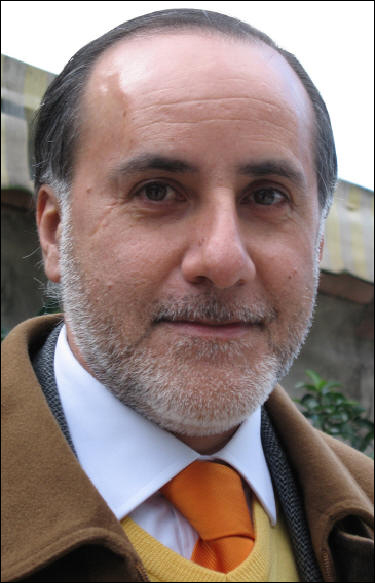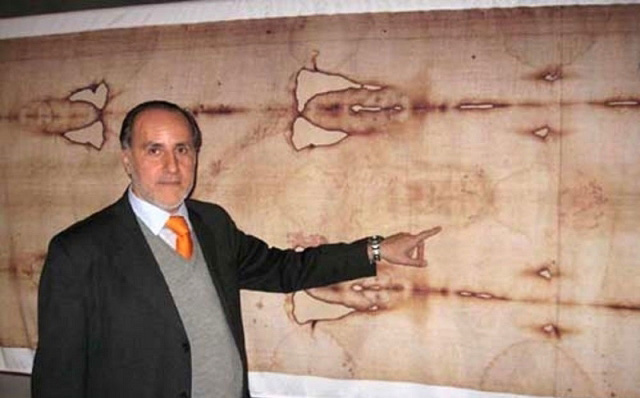Fanti Giulio (b. 1956)
Jakub S. Prauzner-Bechcicki ![]()
Jagiellonian University in Krakow, Poland
(born 1956 in Padua, Italy), Doctor of Engineering (University of Padua, 1982), university teacher. Since 1989, he has worked at the University of Padua, currently as professor (Italian: professore associato confermato) in the Department of Industrial Engineering. One of the founders of the University Centre for Space Studies CISAS “G. Colombo” at the University of Padua (Fanti, Curriculum). He was active in teams working on space projects, including the Giotto spacecraft (to study Halley’s Comet), the Cassini-Huygens spacecraft (to study Saturn). Since the second half of the 1990s, he has conducted intensive research on the Shroud of Turin, focusing on four areas:

- The nature and hypotheses of the origin of the image on the Shroud (→Hypotheses of the Origin of the Image on the Shroud).
- New techniques for determining the age of the cloth and dating the Shroud (→Determination of the Age of the Shroud).
- The fragments taken from the Shroud.
- The man wrapped in the Shroud (→Exegetical and Medical Aspects of Jesus’ Death and Their Coherence with the Shroud).
In matters concerning the image on the Shroud, Professor Fanti is a proponent of the hypothesis that an essential element in the origin of the image is the so-called coronal discharge or otherwise incomplete discharge (→Hypotheses of the Origin of the Image on the Shroud). He presents his position on this issue in numerous papers published in peer-reviewed scientific journals and presented at conferences (see, for example, Fanti 2011; Fanti 2010a; Fanti 2010b; Fanti 2015; Fanti et al. 2005; Fanti, Lattarulo, Scheuermann 2005; Fanti et al. 2010; Lazzaro et al. 2010), as well as in written popular science books (see, for example, Fanti, Malfi 2020).
Another area of research to which Professor Fanti devotes considerable attention in his work is the dating of the Shroud. Aware of the difficulties accompanying the determination of the age of textiles by radiocarbon dating, Fanti proposed a number of methods for studying the age of textiles collectively referred to as opto-mechanical methods (Fanti, Malfi 2013; Fanti, Basso 2017; Fanti, Malfi, Crosilla 2015; Fanti et al. 2013; Bonizzoni et al. 2016; De Caro et al. 2019; De Caro et al. 2022). He applied these in →studies of the age of the Shroud, obtaining a result concerning the time of the cloth’s creation between 120 BC and 292 BC (Fanti, Malfi, Crosilla 2015). In addition, he strengthens his argument in favour of an earlier age of the Shroud by presenting extensive numismatic studies (Fanti, Malfi 2020). This research consists of comparing the image of the Man from the Shroud with images of Christ from coins minted in the Byzantine Empire and in countries under its cultural influence from the late seventh to the mid-15th century. On the basis of these results, Fanti is inclined to hypothesize that the image of the Man from the Shroud was the prototype for the representations of Christ on the coins studied. This would mean that the Shroud was known to at least some Byzantine mincers, which would contradict the age suggested by the radiocarbon studies (these set the age at 1325±65 after Christ—Damond et al. 1989). As Professor Fanti himself admits, the aforementioned numismatic studies have received quite considerable criticism from historians (Fanti, Malfi 2020).
Giulio Fanti, being in possession of the samples taken from the Shroud, collected by the →STURP project (Fanti, Malfi 2020), also carries out research on the flecks from the Shroud. Among other things, he presents results concerning the analysis of blood residues on fibres from the Shroud (Carlino et al. 2017; Laude, Fanti 2017) and the presence of inorganic particles (Fanti, Malfi 2020). Furthermore, in his research Fanti attempts to obtain additional information concerning the Man whose image is visible on the Shroud. This includes the manner in which the body was laid out, wrapped in cloth (Fanti, Malfi 2020), along with traces of the ordeal preceding death, such as the analysis of the marks of the scourging (Faccini, Fanti 2010).

Professor Fanti, together with Mari Latendress, Emanuela Marinelli and Raymond Rogers, initiated The Shroud Science Group, a discussion group bringing together more than 150 researchers involved in the study of the Shroud in 2019 (Fanti, Malfi 2020). He is also the author of dozens of publications (scientific and popular articles, lectures, books) on issues related to the study of the Shroud. The book Il mistero della Sindone. Le sorprendenti scoperte scientifiche sull’enigma del telo di Gesù (2013), written with Saverio Gaeta, is one of his the most important publications (it has been translated into Polish: Tajemnica Całunu. Zdumiewające odkrycia nauki w kwestii Całunu Turyńskiego, Krakow 2015).
References and Syndonological Bibliography
Bonizzoni L. et al., Ageing of Flax Textiles: Fingerprints in Micro-Raman Spectra of Single Fibres, “Microchemical Journal” 2016, Vol. 125, pp. 69–74, http://dx.doi.org/10.1016/j.microc.2015.11.011.
Carlino E. et al., Atomic Resolution Studies Detect New Biologic Evidences on the Turin Shroud, “PLOS ONE” 2017, No. 12(6), pp. 1–13, https://dx.doi.org/10.1371/journal.pone.0180487.
Damond P.E. et al., Radiocarbon Dating of the Shroud of Turin, “Nature” 1989, No. 337, pp. 611–615, http://dx.doi.org/10.1038/337611a0.
De Caro L. et al., X-Ray Dating of Ancient Linen Fabrics, “Heritage” 2019, No. 2(4), pp. 2763–2783, http://dx.doi.org/10.3390/heritage2040171.
De Caro L. et al., X-Ray Dating of a Turin Shroud’s Linen Sample, “Heritage” 2022, No. 5(2), pp. 860–870, http://dx.doi.org/10.3390/heritage5020047.
Faccini B., Fanti G., New Image Processing of the Turin Shroud Scourge Marks, [in:] Proceeding of the International Workshop on the Scientific Approach to the Acheiropoietos Images, a cura di P. Di Lazzaro, ENEA Research Center of Frascati, Frascati 2010, [on-line:] http://www.acheiropoietos.info/proceedings/FacciniWeb.pdff – 13 VII 2022.
Fanti G., Short Curriculum, [online:] http://sindone.dii.unipd.it/giulio.fanti/short%20curriculum%20ingl.html – 23 VI 2022.
Fanti G. et al., Evidences for Testing Hypotheses about the Body Image Formation of the Turin Shroud, [in:] The 3rd Dallas International Conference on the Shroud of Turin, Dallas 8-11 September, 2005.
Fanti G. et al., Microscopic and Macroscopic Characteristics of the Shroud of Turin Image Superficiality, “Journal of Imaging Science and Technology” 2010, Vol. 54, No. 4, pp. 40201-1-40201–8, http://dx.doi.org/10.2352/J.ImagingSci.Technol.2010.54.4.040201.
Fanti G., Can a Corona Discharge Explain the Body Image of the Turin Shroud?, “Journal of Imaging Science and Technology” 2010, Vol. 54, No. 2, 020508, http://dx.doi.org/10.2352/J.ImagingSci.Technol.2010.54.2.020508.
Fanti G., Hypotheses Regarding the Formation of the Body Image on the Turin Shroud: A Critical Compendium, “Journal of Imaging Science and Technology” 2011, Vol. 55, No. 6, pp. 60507-1-60507–14, http://dx.doi.org/10.2352/J.ImagingSci.Technol.2011.55.6.060507.
Fanti G., Comments on a Stochastic Hypothesis about the Body Image Formation of Turin Shroud, “The Journal of The Textile Institute” 2015, Vol. 106, No. 8, pp. 900–903, https://dx.doi.org/10.1080/00405000.2014.961265.
Fanti G., Basso R., Mechanical Characterization of Linen Fibers: The Turin Shroud Dating, “International Journal of Reliability, Quality and Safety Engineering” 2017, Vol. 24, No. 2, 1750006, http://doi.org/10.1142/s0218539317500061.
Fanti G., Lattarulo F., Scheuermann O., Body Image Formation Hypotheses Based on Corona Discharges, [in:] The 3rd Dallas International Conference on the Shroud of Turin, Dallas 8-11 September, 2005.
Fanti G., Malfi P., Multi-Parametric Micro-Mechanical Dating of Single Fibers Coming from Ancient Flax Textiles, “Textile Research Journal” 2013, Vol. 84, No. 7, pp. 714–727, http://dx.doi.org/10.1177/0040517513507366.
Fanti G., Malfi P., The Shroud of Turin: First Century after Christ!, 2nd ed., Singapore 2020, https://doi.org/10.1201/9780429468124.
Fanti G., Malfi R., Crosilla F., Mechanical and Opto-Chemical Dating of the Turin Shroud, “MATEC Web of Conferences, Workshop of Paduan Scientific Analysis on the Shroud (WOPSAS 2015)” 2015, Vol. 36, 01001, https://doi.org/10.1051/matecconf/20153601001.
Fanti G. et al., List of Evidences of the Turin Shroud, [in:] Proceedings of the International Workshop on the Scientific Approach to the Acheiropoietos Images, a cura di P. Di Lazzaro, ENEA Research Center of Frascati, Frascati, 2010, [on-line:] http://www.acheiropoietos.info/proceedings/proceedings.php – 16 VII 2022.
Fanti G. et al., Non-Destructive Dating of Ancient Flax Textiles by Means of Vibrational Spectroscopy, “Vibrational Spectroscopy” 2013, Vol. 67, pp. 61–70, http://dx.doi.org/10.1016/j.vibspec.2013.04.001.
Laude J.-P., Fanti G., Raman and Energy Dispersive Spectroscopy (EDS) Analyses of a Microsubstance Adhering to a Fiber of the Turin Shroud, “Applied Spectroscopy” 2017, Vol. 71, No. 10, pp. 2313–2324, http://dx.doi.org/ 10.1177/0003702817715291.
Lazzaro P.D. et al., Deep Ultraviolet Radiation Simulates the Turin Shroud Image, “Journal of Imaging Science and Technology” 2010, Vol. 54, No. 4, 040302, http://dx.doi.org/10.2352/J.ImagingSci.Technol.2010.54.4.040302.
Source of Images
Private collection, http://sindone.dii.unipd.it/giulio.fanti/
